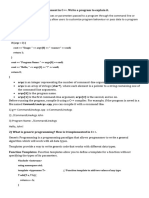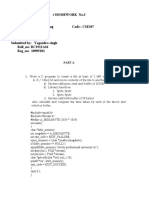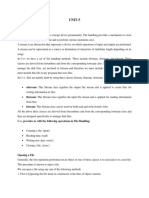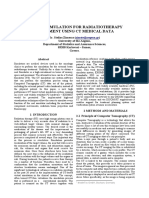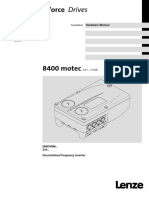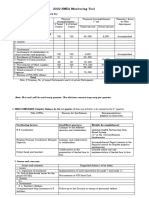Files With Fstream: Short Answer
Files With Fstream: Short Answer
Uploaded by
Khải NguyễnCopyright:
Available Formats
Files With Fstream: Short Answer
Files With Fstream: Short Answer
Uploaded by
Khải NguyễnOriginal Description:
Original Title
Copyright
Available Formats
Share this document
Did you find this document useful?
Is this content inappropriate?
Copyright:
Available Formats
Files With Fstream: Short Answer
Files With Fstream: Short Answer
Uploaded by
Khải NguyễnCopyright:
Available Formats
Course: Programming Techniques (CSC10002)
20CLC3 – 20CLC6
FILES with FSTREAM
Short Answer
1. * What header file do you need to include in a program that performs file operations? // fstream
What data type do you use when you create a file stream object that can write data to a file? ofstream
How about creating a file stream object that can read data from a file? ifstream
để khi mình thực hiện các thao tác khác thì file gốc vẫn giữ
2. * Why should a program close a file when it has finished using it?nguyên và an toàn cho chương trình nếu như các lần sau
mình đọc file đó
3. * What are the differences among these classes, ifstream, ofstream and fstream?
reading/write/Khai báo header file
reading write
4. ** Show your experience when manipulating files with C++ fstream and C FILE class.
5. ** What task does each of the following code segments perform?
• ofstream ofile("file.txt"); tạo file có tên là file.txt sau đó ghi dữ liệu vào file. Cụ thể ở đây là:
goodmorning. Sau đó ghi ra màn hình dòng chữ" dât written to file"
ofile << "goodmorning" << endl;
cout << "Data written to file" << endl;
ofile.close();
• char data[100];
ifstream ifile("file.txt"); đọc dữ liệu từ file vào biến data sau đó xuất biến data ra màn hình
while ( !ifile.eof() ) {
ifile.getline (data, 100);
cout << data << endl;
}
ifile.close();
6. ** What is the content of the file “file.txt”after each of the following code segment executes?
• ofstream ofile("file.txt");
ofile << "hello new day", 13; nội dung của file là:
hello new month
ofile.seekp(9);
ofile << " month", 6;
ofile.close();
• ofstream outfile("file.txt");
outfile.write ("This is an apple",16);
long pos = outfile.tellp(); This is a sample
outfile.seekp (pos - 7);
outfile.write (" sam", 4);
outfile.close();
Nguyễn Ngọc Thảo – Bùi Huy Thông
1 HCMUS
7. ** The file expenses.txt contains the line: Hotel, 3 nights, $ 1750.25
Are the results of the two code segments below the same? If not, point out the difference(s).
ifstream in("expenses.txt"); ifstream in("expenses.txt");
char c; char c;
while (in.get(c)){ while (in.get(c)){
if (isdigit(c)) { if (isdigit(c)) {
in.unget(); in.unget();
double n; int n; 3
3
in >> n; in >> n;
cout << n << 'x'; cout << n << 'x';
} }
} }
8. ** Are the three following code
No
segments the same? If not, point out the difference(s).
ifstream in("file.txt"); ifstream in("file.txt"); ifstream in("file.txt");
char x; string x; string x;
int i{0}; int i{0}; int i{0};
while (in.get(x)) while (getline(in, x)) while (in >> x)
i++; //tựsốkhoảng
lượng kí tự trong file, kể cả kí
trắng
i++; // số lượng dòng ở trong file i++; // số lượng kí tự có trong file kể cả kí tự khoảng trắng
cout << i << endl; cout << i << endl; cout << i << endl;
9. ** There may be complie/runtime errors in the following code segment. Identify them.
• ifstream myStream;
ifstream.Open("file.txt", ios::out); // ifstream.open("file.txt",ios::in);
• int l;
char * b;
ifstream i;
i.open ("find.txt", ios :: binary ); // i.open("find.txt",ios::in|ios::binary);
i.seekg (0, ios :: end);
l = i.tellg();
i.seekg (0, ios :: beg);
b = new char [l];
i.read (b, l); sizeof(b)
i.close();
cout.write (b, l); sizeof(b)
delete[] b;
10. *** What screen output does each of the following code segments produce, and why?
• char character;
int integer;
ofstream out_stream;
ifstream in_stream;
/* Create a file containing two integers */
file Integers
out_stream.open("Integers"); 123 456
out_stream << 123 << '" " ' << 456;
out_stream.close();
Nguyễn Ngọc Thảo – Bùi Huy Thông
2 HCMUS
/* Attempt to read a character, then an integer, then a character
again, then an integer again, from the file "Integers". */
in_stream.open("Integers");
1 23
in_stream >> character >> integer;
1
cout << "character: '" << character << "'\n"; Output:
23 character: 1
cout << "integer: " << integer << "\n"; integer: 23
4 56
in_stream >> character >> integer; character: 4
4 integer: 56
cout << "character: '" << character << "'\n";
56
cout << "integer: " << integer << "\n";
in_stream.close();
• ofstream output; // ghi dữ liệu từ chương trình ra file scores.txt
output.open("scores.txt");
// Write two lines
output << "John" << " " << "T" << " " << "Smith" << " " << 90<<endl;
output << "Eric" << " " << "K" << " " << "Jones" << " " << 85;
File scores:
output.close(); John T Smith 90
Eric K Jones 85
ifstream input;
// Open a file // Mở file scores để đọc dữ liệu từ file vào chương trình
input.open("scores.txt");
// Read data
char firstName[80], lastName[80];
char mi;
int score;
input >> firstName >> mi >> lastName >> score;
90
double sum = score; Jones 85
Eric K
input >> firstName >> mi >> lastName >> score;
sum += score; 175
cout << "Total score is " << sum << endl;
input.close();
Total score is 175
Nguyễn Ngọc Thảo – Bùi Huy Thông
3 HCMUS
Fill-in-the-Blank
1. * Fill in each of the following blanks with an appropriate terminology
• ____________________
file's read position marks the location of the next byte that will be read from the file.
• This file access method is similar to the way cassette tape players work: _______________________.
sequential access
Meanwhile, this method is similar to the way a CD/MP3 player works: __________________________.
random file access
• The statement, _____________________________,
in>>word reads a single word from the ifstream named in
into the string variable word.
• You can use the ________________
seekp() function to move the file pointer for output and the ____________
seekg
function to move the file pointer for input. In these functions, the first argument indicates the
__________________
offset and the second argument indicates the ________________________.
mode
2. ** For each of the following cases, identify what the code segment will print out, given the content
of the input file.
• ifstream ifile("file.txt");
char last;
ifile.ignore (256, ' '); programming techniques
bỏ qua các kí tự cho đến khi gặp dấu cách thì dừng lại
last = ifile.get();
cout << "Your initial is " << last << '\n';
ifile.close();
The content of the file “file.txt” is "programming techniques"
What printed out is _____________________________________________________________________________
Your initial is t
• ifstream in("file.txt"); mở file ra để đọc dữ liệu từ file vào chương trình
char c;
int i = 0;
while (in.get(c)){
if (tolower(c) == 'a') i++;
} If I saw an Aardvark, I would scream!
cout << i << endl;
The content of the file “file.txt” is "If I saw an Aardvark, I would scream!"
What printed out is _____________________________________________________________________________
6
• ifstream in("file.txt");
char c;
while (in.get(c)){
if (isupper(c))
cout << toupper(c);
}
in.close();
The content of the file “file.txt” is "Orange Coast College"
What printed out is _____________________________________________________________________________
OCC
Nguyễn Ngọc Thảo – Bùi Huy Thông
4 HCMUS
• string word;
int i = 0;
ifstream read("file.txt");
while(read >> word){
if(i < word.length())
cout << word[i];
++i;
}
cout << endl;
The content of the file “file.txt” is
"The whole thing starts about twelve, fourteen or seventeen"
What printed out is _____________________________________________________________________________
Thirteen
3. ** Consider the following statement,
ofstream ofs;
ofs.open ("file.txt", _______________________);
ios::out
What should be filled in the blank so that the writing position starts at the end of the file?
4. ** The file grades.txt contains lines of text that look like this:
Smith 94
Jones 75
. . .
Each line of text contains the student's name (a single word) and an integer score.
Consider the following code segment,
string name;
int score;
ifstream in("grades.txt");
in>>name;
What is the legal way of reading one student's information?________________________________________
in>>score
5. *** The file grades.txt contains lines of text that look like this:
1 student1 3.5
2 student2 0.6
3 student3 4.0
4 student4 2.2
5 student5 2.3
. . .
Each line of text contains the student’s ID, name (a single word) and score.
Fill in the blanks in the following C++ code segment so that the code will read the text file above
to find a student with a specific ID and then print his/her name and GPA.
Nguyễn Ngọc Thảo – Bùi Huy Thông
5 HCMUS
string idToLookFor, id, name, gpa;
cout << "Enter student ID: ";
cin >> ____________________;
idToLookFor
_____________
ifstream din;
din.open( __________________
"grades.txt",ios::in );
if ( _______________
din.fail() )
cout << "Error. Unable to open file.\n";
else{
while((din >> id) && (id != idToLookFor))
din >> name >> gpa;
if ( ___________
id == idToLookFor ){
din >> ________________________ ;
name>>gpa
cout << "Student name: " << name << " GPA: " << gpa;
}
else
cout << "The student was not found." << endl;
din.__________;
close()
Nguyễn Ngọc Thảo – Bùi Huy Thông
6 HCMUS
True or False
Choose T (True) or F (False) for each of the following statements and then briefly explain in one or two
sentences.
1. T F There is no way to jump directly to the desired data in a text file.
2. T F The function eof is used for appending data to the end of a file.
3. T F It is possible to open several files for access at the same time.
4. T F If a file you are opening for appending does not exist, the operating system will detect the
missing file and terminate the operation.
5. T F If you create a file with the same name as an existing file, you will be always prompted to
rename your new file by the file creation function.
6. T F When you call an ofstream object’s open member function, the specified file will be
erased if it already exists. nội dung trong file bị xóa chứ không phải nó bị xóa
7. T F The return value of the getline function is an input stream object
8. T F The return value of the getline function is a string object.
9. T F If an input stream's file is missing when you try to open it, its member function fail
returns false.
10. T F If an output stream's file is missing when you try to open it, its member function fail
returns false.
Nguyễn Ngọc Thảo – Bùi Huy Thông
7 HCMUS
Algorithm Workbench
1. * Write a single statement to complete each of the following requirements
• Create an input file stream object named in and open the text file tuba.txt.
• Assume the text file tuba.txt contains several lines of text. Read one line from this file using
the input file stream object in
• Create an output file stream object named out and open the text file expenses.dat.
• Output the string “Hello Word” to the text file expenses.dat using the output file stream
object out.
2. ** Assume that the text file named Numbers.txt contains integers from 1 to 100 and these
numbers are separated by white blanks. Write code to read integers from the text file
Numbers.txt and output only prime numbers.
3. ** Write code to loop from 1 to 100 and write only Fibonacci numbers to the text file named
Fibonacci.txt.
Consider the following children poem as demonstration of text input data for Question 4 to 8.
i made myself a snowball
as perfect as could be
i thought i would keep it as a pet
and let it sleep with me
i made it some pajamas
and a pillow for its head
then last night it ran away
but first it wet the bed
Source: https://www.familyfriendpoems.com/poem/snowball-by-shel-silverstein
4. ** Write code to write the above content to the text file named Snowball.txt.
5. ** Write code to count the frequency of every distinct word in the text file Snowball.txt and store
these words (along with their frequencies), one per line, to a new text file named Freq.txt.
6. ** Write code to replace every instance of the word “it” in the text file Snowball.txt by the word
“snowball” and write the new content to the text file named newSnowball.txt.
7. ** Write code to receive a positive integer that is no larger than the number of lines in the text file
Snowball.txt and delete the corresponding line.
8. ** Write code to receive a positive integer that is no larger than the number of lines in the text file
Snowball.txt and insert the line “i love snowball” to the corresponding line.
Nguyễn Ngọc Thảo – Bùi Huy Thông
8 HCMUS
9. ** Consider the following two text files, FileA and FileB.
i never saw a purple cow the forest is the town of trees
i never hope to see one where they live quite at their ease
but i can tell you, anyhow with their neighbors at their side
i would rather see than be one just as we in cities wide
Merge these two files into a single file such that their lines come in an alternative fashion, that is,
the first line of FileA goes first and it is followed by the first line of FileB, and then the second
line of FileA and FileB, respectively, and so on.
10. *** Use some encryption algorithm to encrypt the file Snowball.txt and store the encrypted
content to the file Snowball.enc. After that, decrypt the previously encrypted file and store the
decrypted content to the file Snowball.dec .
Nguyễn Ngọc Thảo – Bùi Huy Thông
9 HCMUS
You might also like
- 06 Input OutputDocument29 pages06 Input OutputZHEN-HONG LEENo ratings yet
- File - Handling (Stream I/O) : Flow of DataDocument21 pagesFile - Handling (Stream I/O) : Flow of DataRama SugavanamNo ratings yet
- File Hanling - New - C++Document26 pagesFile Hanling - New - C++Shubham agrayNo ratings yet
- CP Week 04 CPP FilesDocument21 pagesCP Week 04 CPP Fileskamran2021No ratings yet
- C++ HandoutDocument6 pagesC++ HandoutPetros AbebeNo ratings yet
- File Handling in C++Document17 pagesFile Handling in C++Sunil SuryawanshiNo ratings yet
- EC-241 Object-Oriented ProgrammingDocument33 pagesEC-241 Object-Oriented ProgrammingRaza UllahNo ratings yet
- Data File HandlingDocument41 pagesData File HandlingAman Kamboj100% (1)
- Data File Handling in C++: Key PointsDocument6 pagesData File Handling in C++: Key PointsMitesh KumarNo ratings yet
- Practical 11 FilesDocument9 pagesPractical 11 FilesJing ZeNo ratings yet
- File Handling in C++Document27 pagesFile Handling in C++Deepankar ChhabraNo ratings yet
- File Handling in C++: Objective: To Insert Some Data On A Text FileDocument10 pagesFile Handling in C++: Objective: To Insert Some Data On A Text FileRitik MadaanNo ratings yet
- Oop Unit 4Document38 pagesOop Unit 4jayesh.patilcomp23No ratings yet
- Opening and Closing A File in C++Document4 pagesOpening and Closing A File in C++Pragya PandyaNo ratings yet
- FILE HandlingDocument62 pagesFILE HandlingUjef MalekNo ratings yet
- Oop-Unit IvDocument14 pagesOop-Unit IvTanvirNo ratings yet
- Random Access 5THUNIT 2Document30 pagesRandom Access 5THUNIT 2amit_pagal1995No ratings yet
- CS210 - OOP Using C++ Lab 11-A: Input/Output With FilesDocument5 pagesCS210 - OOP Using C++ Lab 11-A: Input/Output With FilessamiNo ratings yet
- Unit 5 File HandlingDocument9 pagesUnit 5 File Handlingvirenlahane7No ratings yet
- M5 FilehandlingDocument32 pagesM5 FilehandlingMalavika VipinNo ratings yet
- File Handling in CDocument17 pagesFile Handling in CRashmi AgrawalNo ratings yet
- CP Chapter 7Document29 pagesCP Chapter 7abelcreed1994No ratings yet
- Object Oriented Programming: File Handling in C++Document58 pagesObject Oriented Programming: File Handling in C++Salman Javed BajwaNo ratings yet
- OOP impDocument26 pagesOOP impvaibhav koreNo ratings yet
- File Handling in C++Document10 pagesFile Handling in C++Ashutosh SharmaNo ratings yet
- FOP Lab 6Document17 pagesFOP Lab 6Arsalan RafiqueNo ratings yet
- C++ Slides - 6: File Handling: Formatted I/O, Hierarchy of File Stream Classes, OpeningDocument26 pagesC++ Slides - 6: File Handling: Formatted I/O, Hierarchy of File Stream Classes, OpeningArshpreet SinghNo ratings yet
- C++ ProgrammingDocument120 pagesC++ ProgrammingKenny KNo ratings yet
- Split and Serial Iz AbleDocument9 pagesSplit and Serial Iz Able6 4 8 3 7 JAYAASRI KNo ratings yet
- 18 - Disk IODocument9 pages18 - Disk IOAzhar JamilNo ratings yet
- Chapter-4-File Input-Output in CPPDocument68 pagesChapter-4-File Input-Output in CPPBereket MuniyeNo ratings yet
- Console I/O Operations Console I/O OperationsDocument66 pagesConsole I/O Operations Console I/O OperationsKaran SharmaNo ratings yet
- C++ Data File Handling SolutionDocument20 pagesC++ Data File Handling SolutionSaransh MathurNo ratings yet
- Classes For File Stream Operation: Stream-Object - Open ("Filename", Mode)Document9 pagesClasses For File Stream Operation: Stream-Object - Open ("Filename", Mode)munoNo ratings yet
- Lab 12 Filing - 2Document21 pagesLab 12 Filing - 2Atta Ur RahmanNo ratings yet
- CSE207 HW3 - SolutionDocument6 pagesCSE207 HW3 - SolutionYogendra SinghNo ratings yet
- FileDocument49 pagesFileTeresa JencyNo ratings yet
- Oop Unit VDocument18 pagesOop Unit VdevalepavanNo ratings yet
- CS 247 Assignment TwoDocument3 pagesCS 247 Assignment TwokarllixiangyuNo ratings yet
- Eee145 Ch8file8633Document18 pagesEee145 Ch8file8633Sems KrksNo ratings yet
- التدفقات والملفات - الفصل الثاني عشرDocument6 pagesالتدفقات والملفات - الفصل الثاني عشرlearn716439No ratings yet
- Data File Handling in C++Document10 pagesData File Handling in C++Sarthak RoyNo ratings yet
- File HandlingDocument12 pagesFile Handlingmanimadhan396No ratings yet
- Unit 5Document19 pagesUnit 5sy9193355161No ratings yet
- Chapter 6Document5 pagesChapter 6wednesday262626No ratings yet
- PF-Lab-16-File HandlingDocument6 pagesPF-Lab-16-File Handlingsans42699No ratings yet
- Wa0004.Document24 pagesWa0004.Tanisha WaichalNo ratings yet
- Chapter-7 Data File HandlingDocument20 pagesChapter-7 Data File Handlingashema compSciNo ratings yet
- Unit 5 Module 2 Data Hierarchy in ObjectDocument27 pagesUnit 5 Module 2 Data Hierarchy in ObjectKeshav KumarNo ratings yet
- Unit VDocument6 pagesUnit Vmanishhadiabad70No ratings yet
- files_inc++Document3 pagesfiles_inc++aliabeed323No ratings yet
- File Handling in C PDFDocument86 pagesFile Handling in C PDFDeepak ShakyaNo ratings yet
- ShahzadDocument8 pagesShahzadSyed Abrar Haider GillaniNo ratings yet
- Oop Notes Unit 4Document12 pagesOop Notes Unit 4Shriram KulkarniNo ratings yet
- EEE 121 ReviewerDocument28 pagesEEE 121 ReviewerAllen Lois LanuzaNo ratings yet
- Lab 07Document7 pagesLab 07gbikornoNo ratings yet
- File Input-Output in CPPDocument68 pagesFile Input-Output in CPPEsubalew ChekolNo ratings yet
- File Handling in JAVADocument26 pagesFile Handling in JAVASajan KunarNo ratings yet
- 7 Data File HandlingDocument40 pages7 Data File HandlingSatayNo ratings yet
- Radio Rav 4 PDFDocument366 pagesRadio Rav 4 PDFJulio GrajedaNo ratings yet
- Comminution in Mineral ProcessingDocument23 pagesComminution in Mineral ProcessinggtdomboNo ratings yet
- Indian Geography Handwritten Notes by Amol Antarkar Sir IgniteDocument168 pagesIndian Geography Handwritten Notes by Amol Antarkar Sir IgniteHarish ChoudharyNo ratings yet
- Management Review Is Presided and Managed byDocument4 pagesManagement Review Is Presided and Managed bymohammedNo ratings yet
- Od428582175123742100 1Document1 pageOd428582175123742100 1ashishsen1096No ratings yet
- Introduction To PropellerDocument12 pagesIntroduction To Propellersaumya irugalbandaraNo ratings yet
- Double Page Spread AnalysisDocument3 pagesDouble Page Spread AnalysisLucy ChrimesNo ratings yet
- Question Bank All - RPTDocument3 pagesQuestion Bank All - RPTDivyNo ratings yet
- Virtual Simulation For Radiatiotherapy Treatment Using CT Medical DataDocument7 pagesVirtual Simulation For Radiatiotherapy Treatment Using CT Medical Datasangeetha maniNo ratings yet
- Define WorkDocument26 pagesDefine Workcarlos juarezNo ratings yet
- Layered Process Audit: Startup Checklist: in The Right ColumnDocument1 pageLayered Process Audit: Startup Checklist: in The Right ColumnadrianNo ratings yet
- Module 3-4 CS 315Document8 pagesModule 3-4 CS 315Princess Joy SarmaNo ratings yet
- OPC SchedulerDocument444 pagesOPC SchedulerSayandeep BanikNo ratings yet
- Bankers Algorithm in JavaDocument3 pagesBankers Algorithm in JavaMaria. NNo ratings yet
- Assignment No 3 MaterialsDocument11 pagesAssignment No 3 MaterialsYasir MalikthNo ratings yet
- FortiOS 5.6 VoIP - SolutionsDocument123 pagesFortiOS 5.6 VoIP - SolutionsBeit ChigumbaNo ratings yet
- Sample Calculation To Implement Outcome-Based Education (OBE) Model at Your Institution - RE - LearningDocument11 pagesSample Calculation To Implement Outcome-Based Education (OBE) Model at Your Institution - RE - LearningPrincipal Om Dayal Group of InstitutionsNo ratings yet
- General CatalogDocument24 pagesGeneral CatalogAravindhan ENo ratings yet
- Electronic Reserva On Slip (ERS) : 6507805435 13307/gangasutlej Exp Sleeper (SL)Document1 pageElectronic Reserva On Slip (ERS) : 6507805435 13307/gangasutlej Exp Sleeper (SL)Ornate JwelleryNo ratings yet
- Electrical Machines Two Marks Noorul Islam Colleege of Engineering KumaracoilDocument6 pagesElectrical Machines Two Marks Noorul Islam Colleege of Engineering KumaracoilSuresh DulamNo ratings yet
- Royal Enfield: 148cc ENSIGN I, II and III and 148cc PRINCE Including AIRFLOW ModelsDocument27 pagesRoyal Enfield: 148cc ENSIGN I, II and III and 148cc PRINCE Including AIRFLOW ModelsroyceNo ratings yet
- E84DGxx - 8400 Motec - v9-1 - ENDocument234 pagesE84DGxx - 8400 Motec - v9-1 - ENjoeprakash cNo ratings yet
- Detect: Wheelscan Wheel Profile Measurement TechnologyDocument2 pagesDetect: Wheelscan Wheel Profile Measurement Technologyingjasilva TNo ratings yet
- IndexDocument6 pagesIndexabdullahsikandar6560No ratings yet
- P770ZM EsmDocument116 pagesP770ZM EsmRoberto LozanoNo ratings yet
- Group 3 ThesisDocument24 pagesGroup 3 ThesisJacob CarniceNo ratings yet
- Krish Rajpal 200103120 CV CombinedDocument1 pageKrish Rajpal 200103120 CV CombinedtushartrayNo ratings yet
- 2022 Smea Monitoring Tool: All Ppas Listed in The Aip With or Without FundsDocument5 pages2022 Smea Monitoring Tool: All Ppas Listed in The Aip With or Without FundsAriel LaguitaoNo ratings yet
- ISO-Lecture 03 - Internal Is and Enterprise SystemsDocument4 pagesISO-Lecture 03 - Internal Is and Enterprise SystemsFadika Malick Christ ElyséeNo ratings yet
- CAIRN-TSG-M-SP-0026-B1-Specification For Basket FilterDocument10 pagesCAIRN-TSG-M-SP-0026-B1-Specification For Basket FilterMurli RamchandranNo ratings yet























